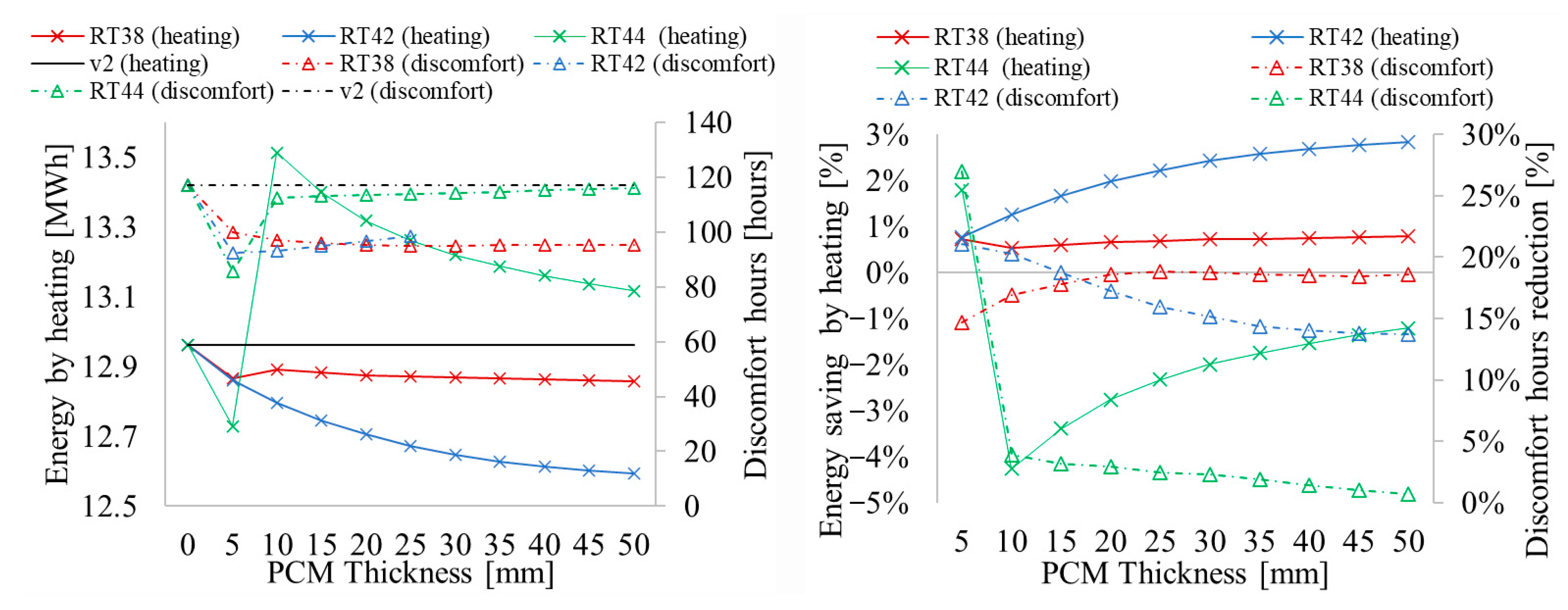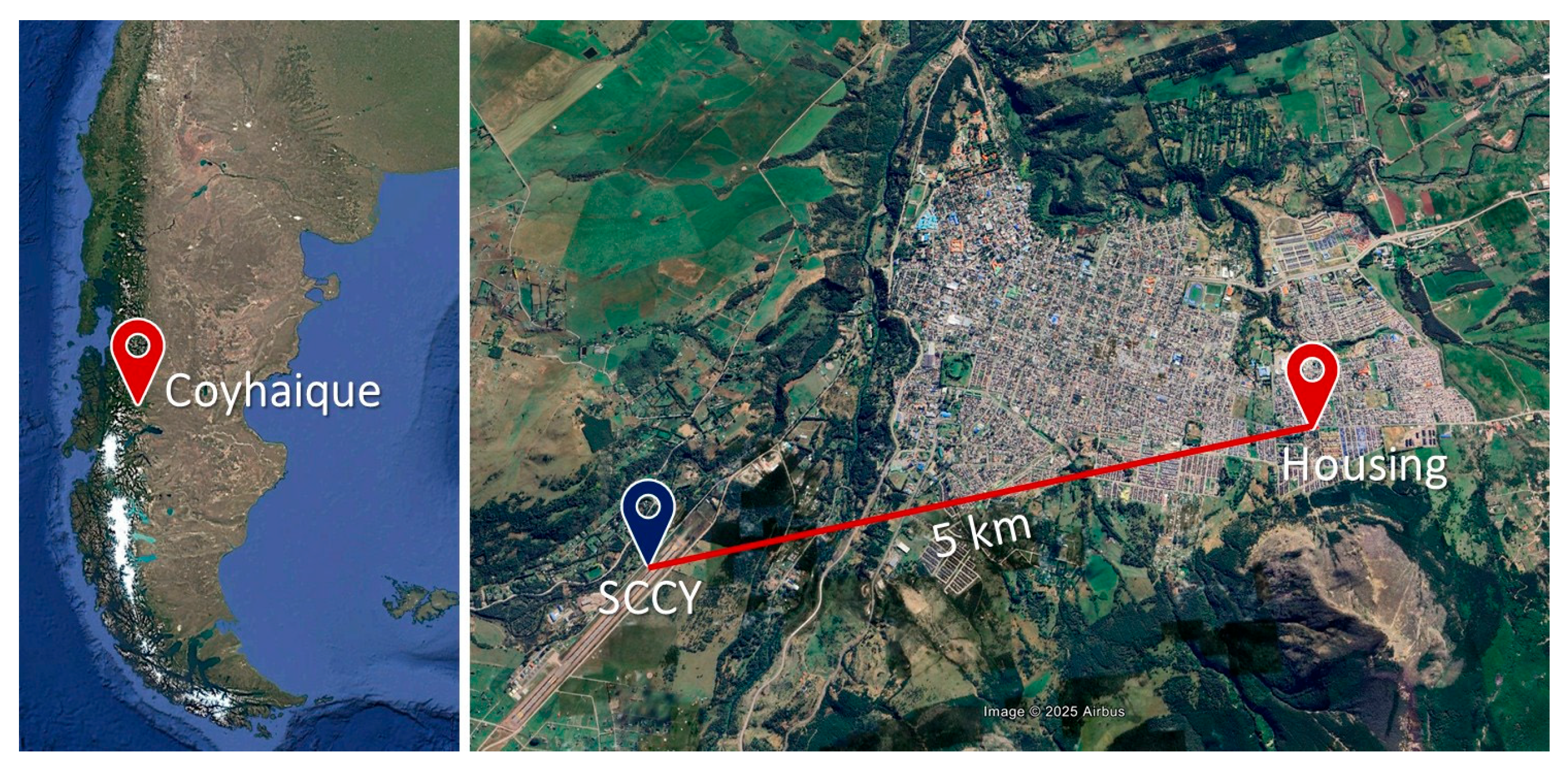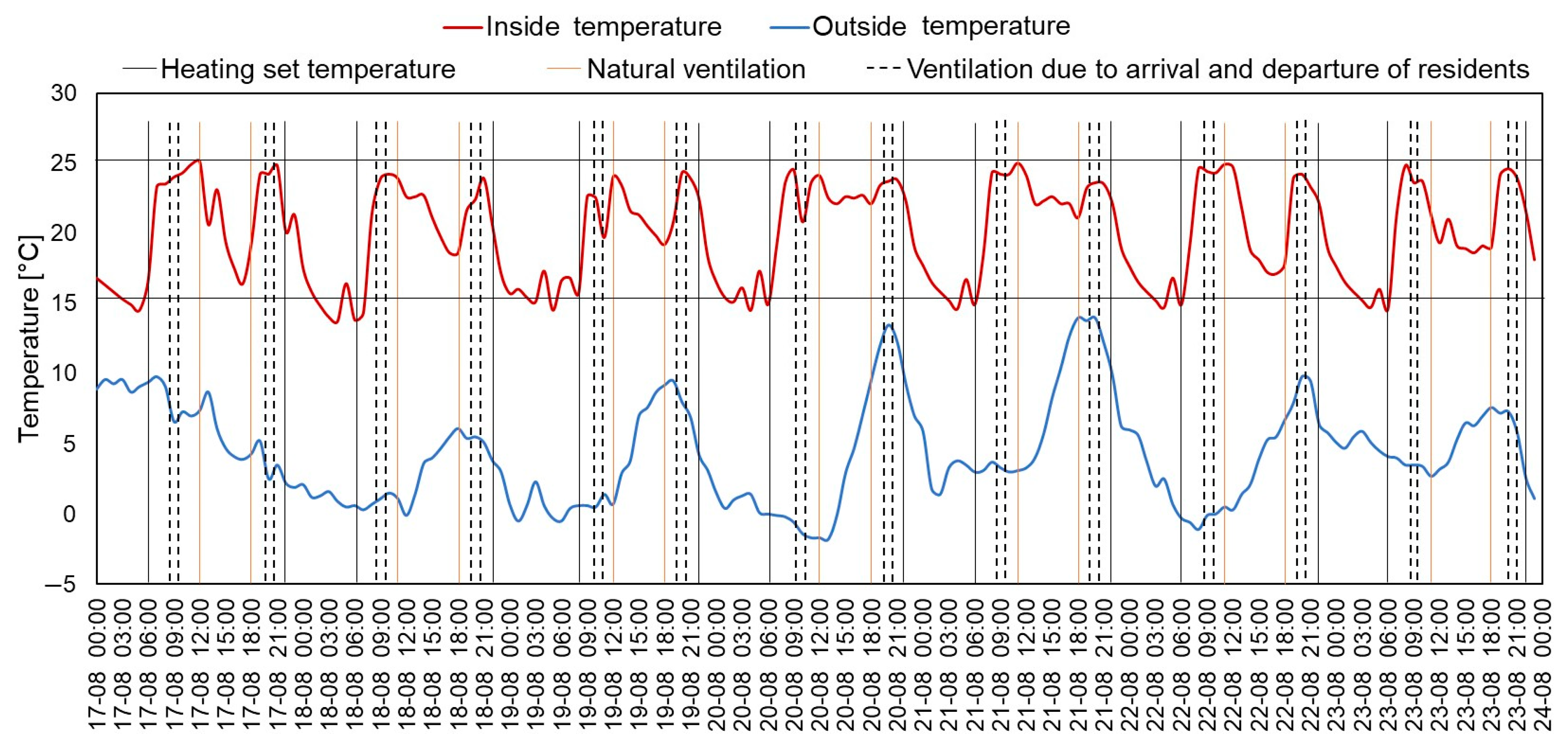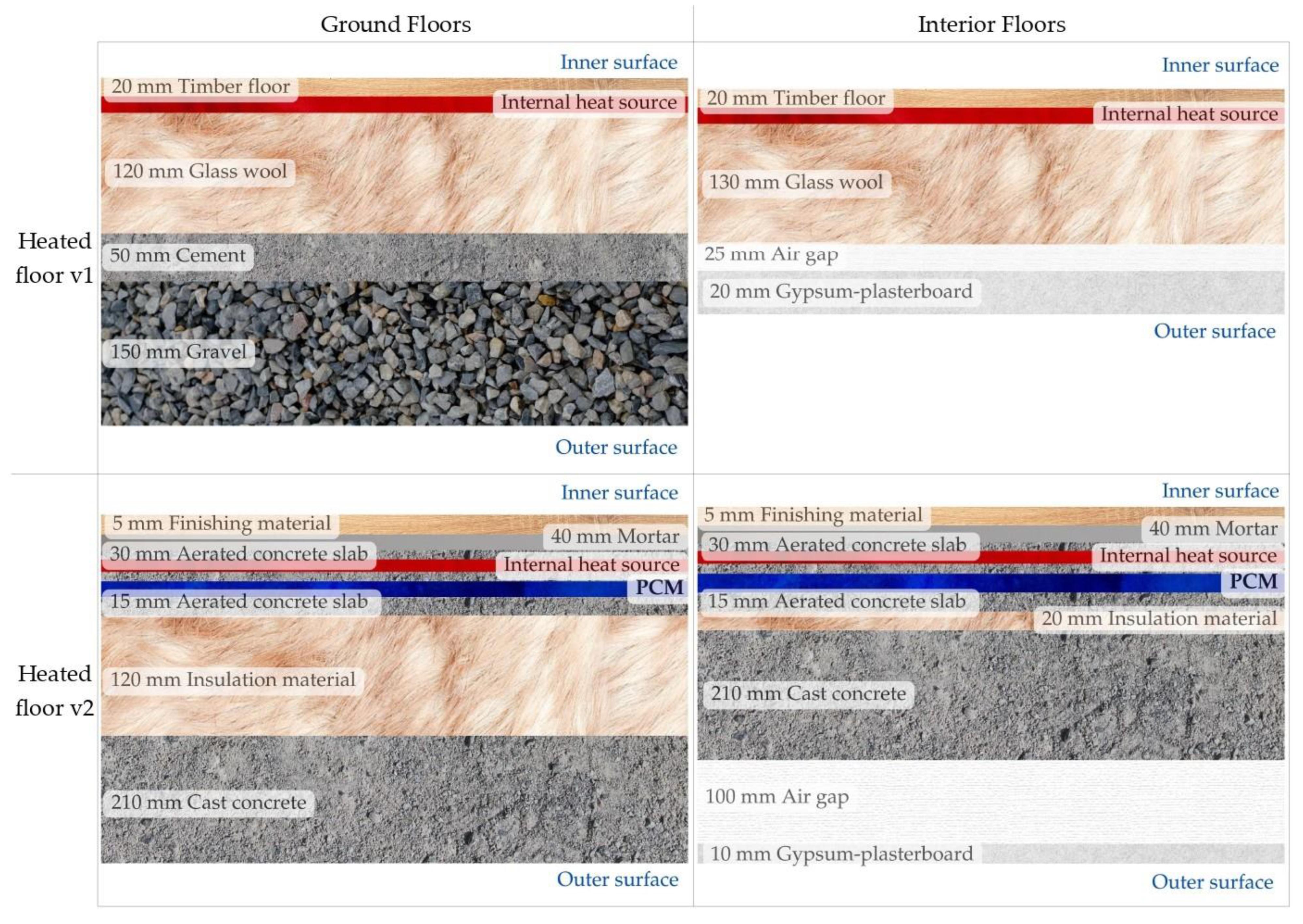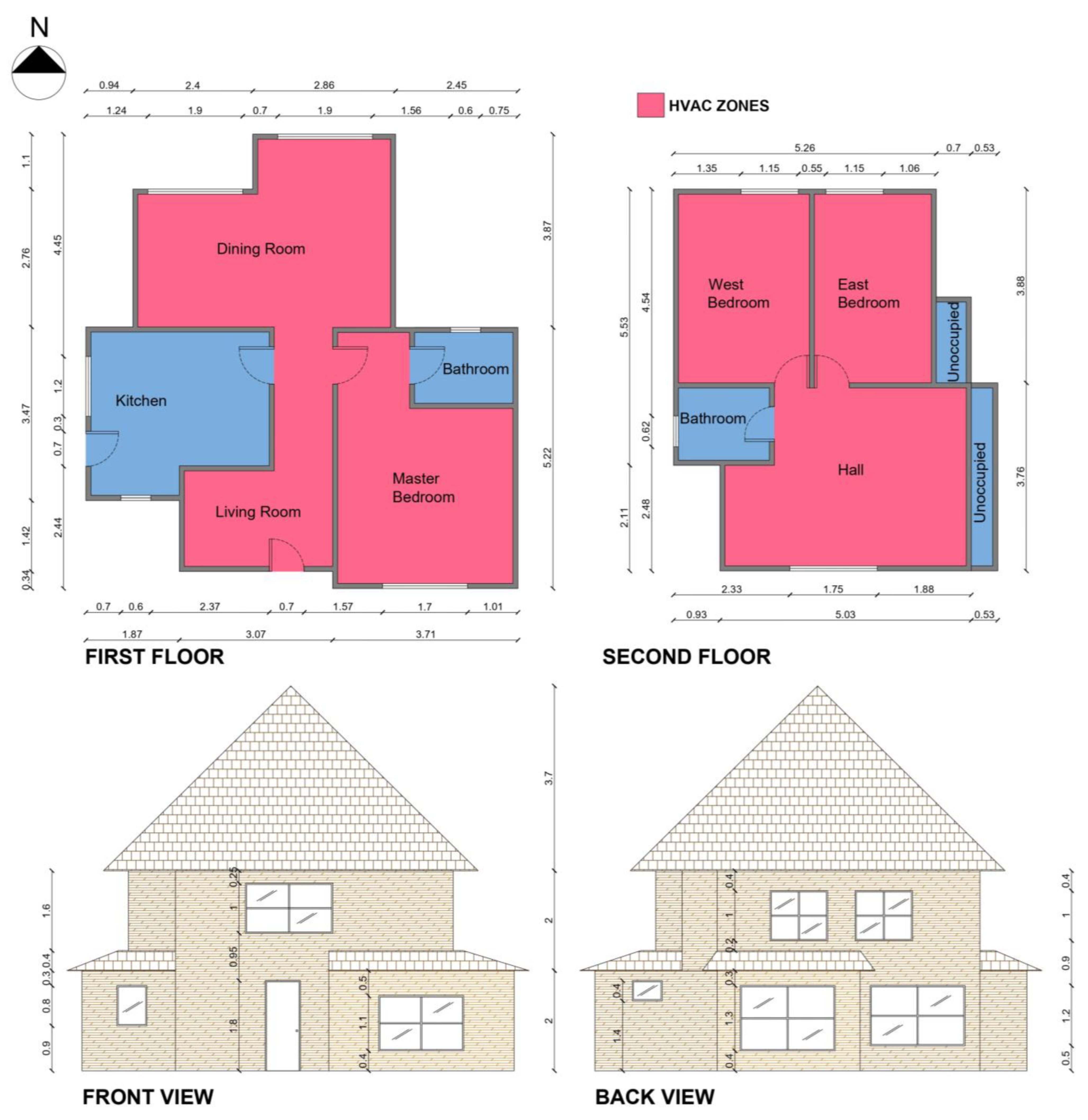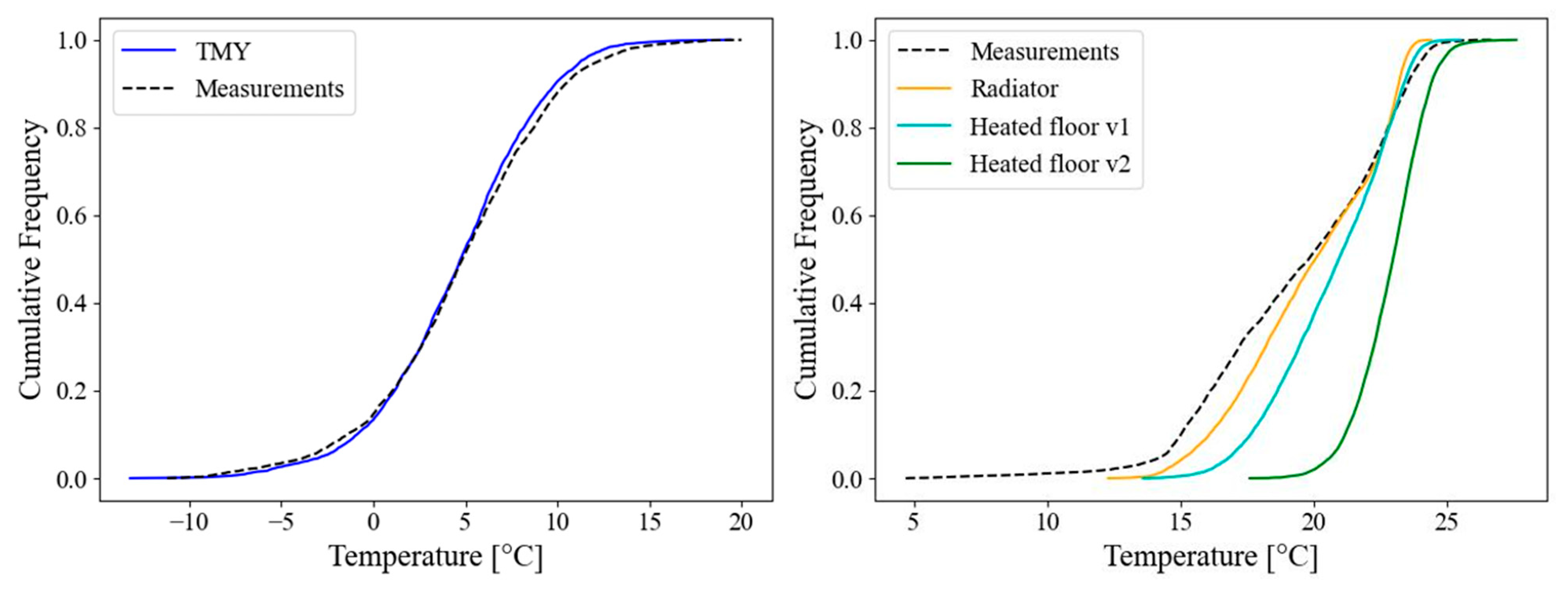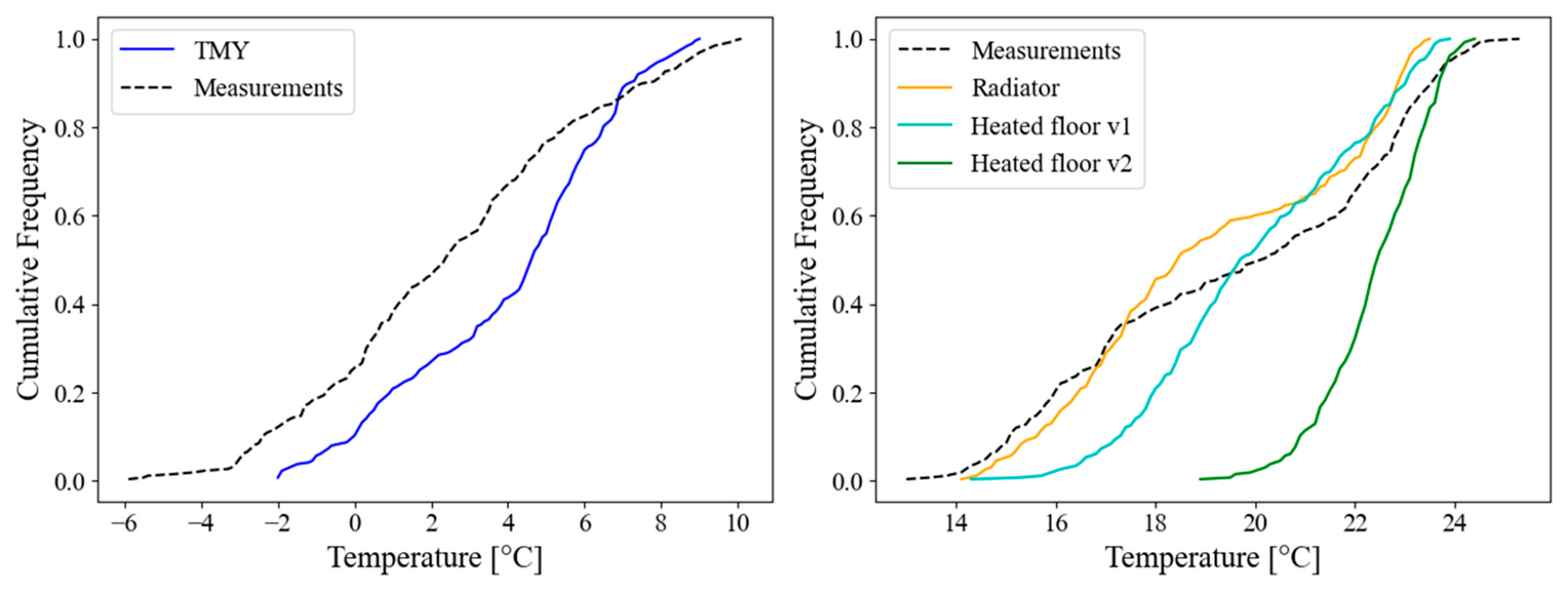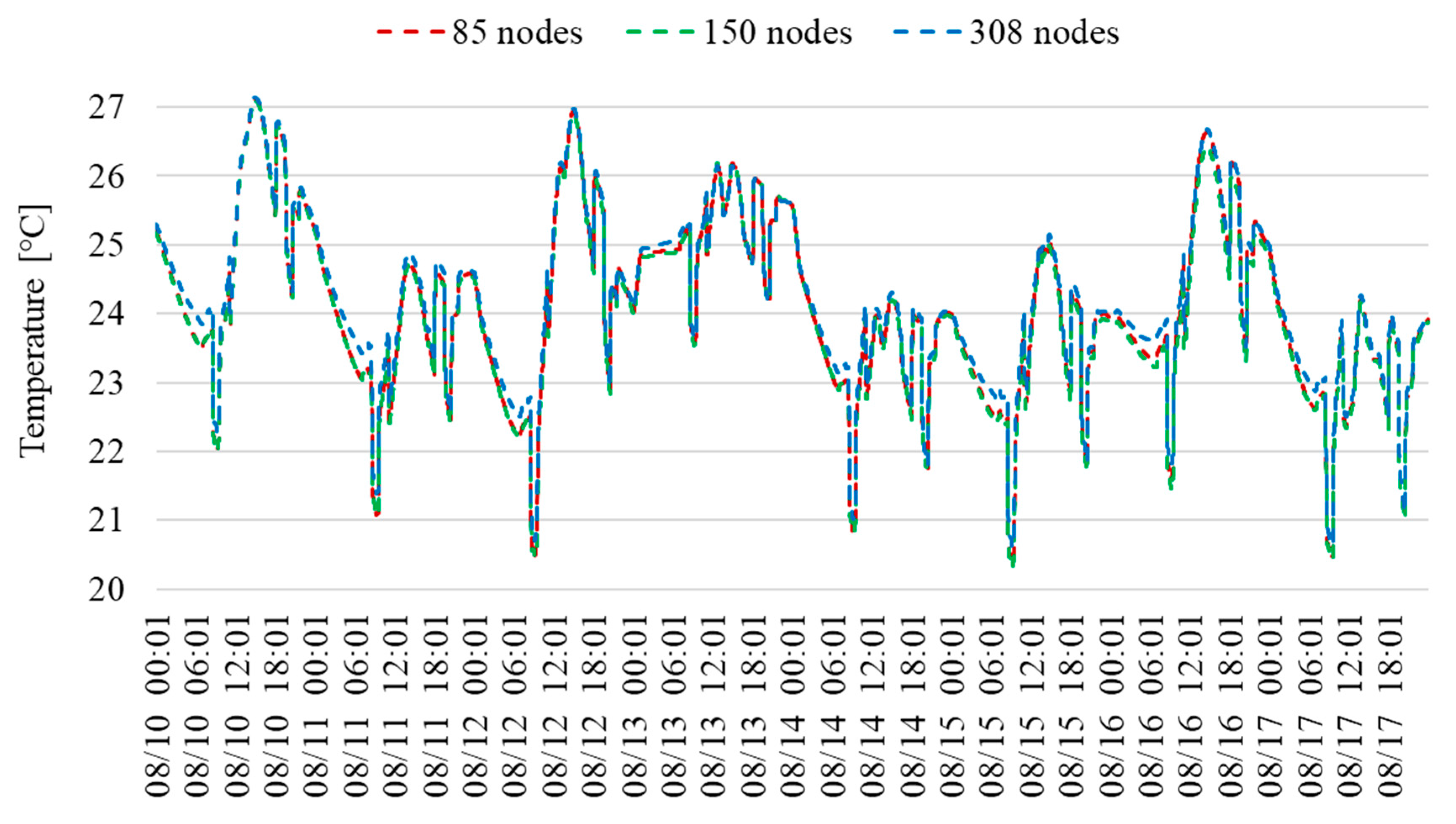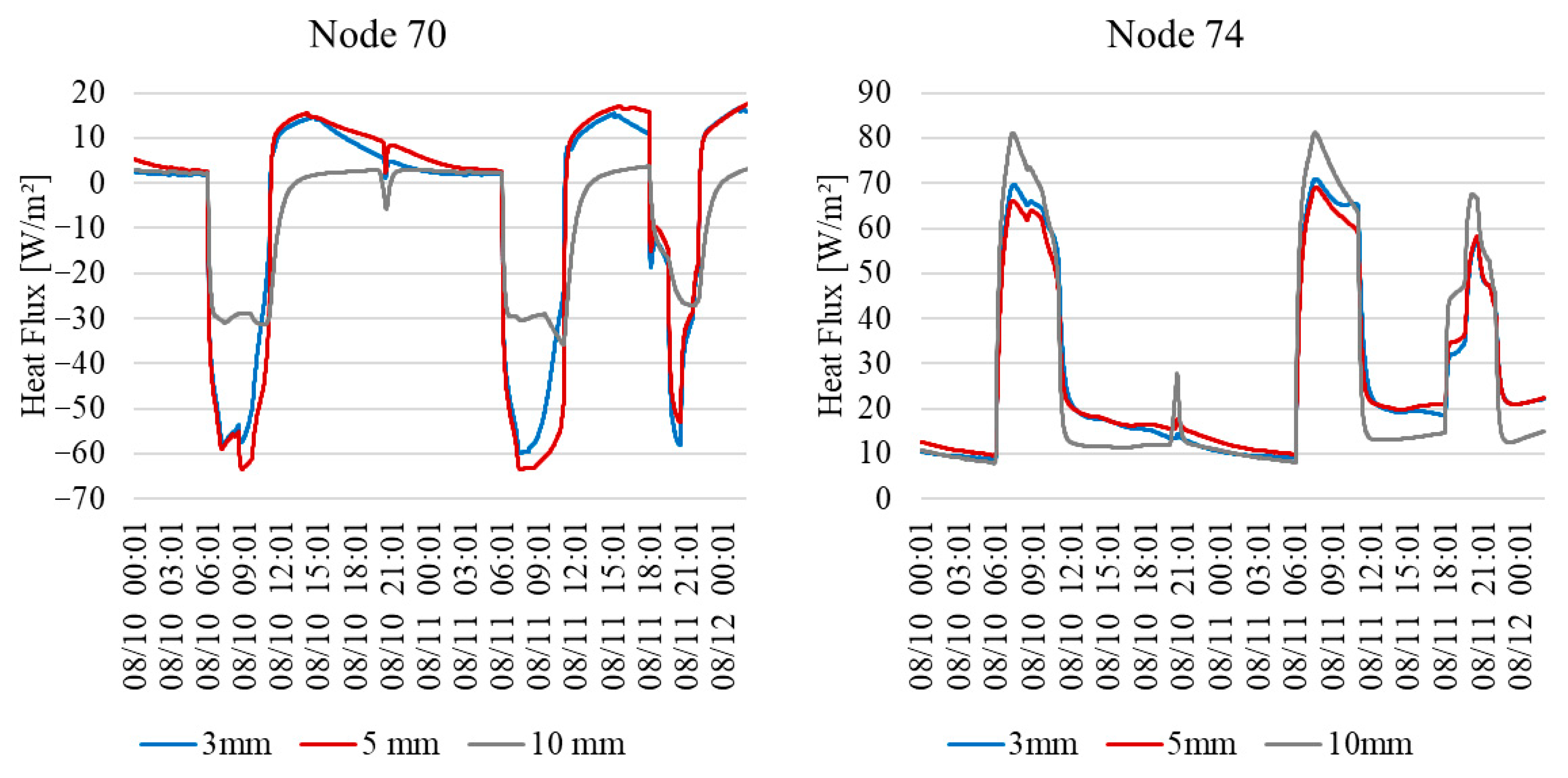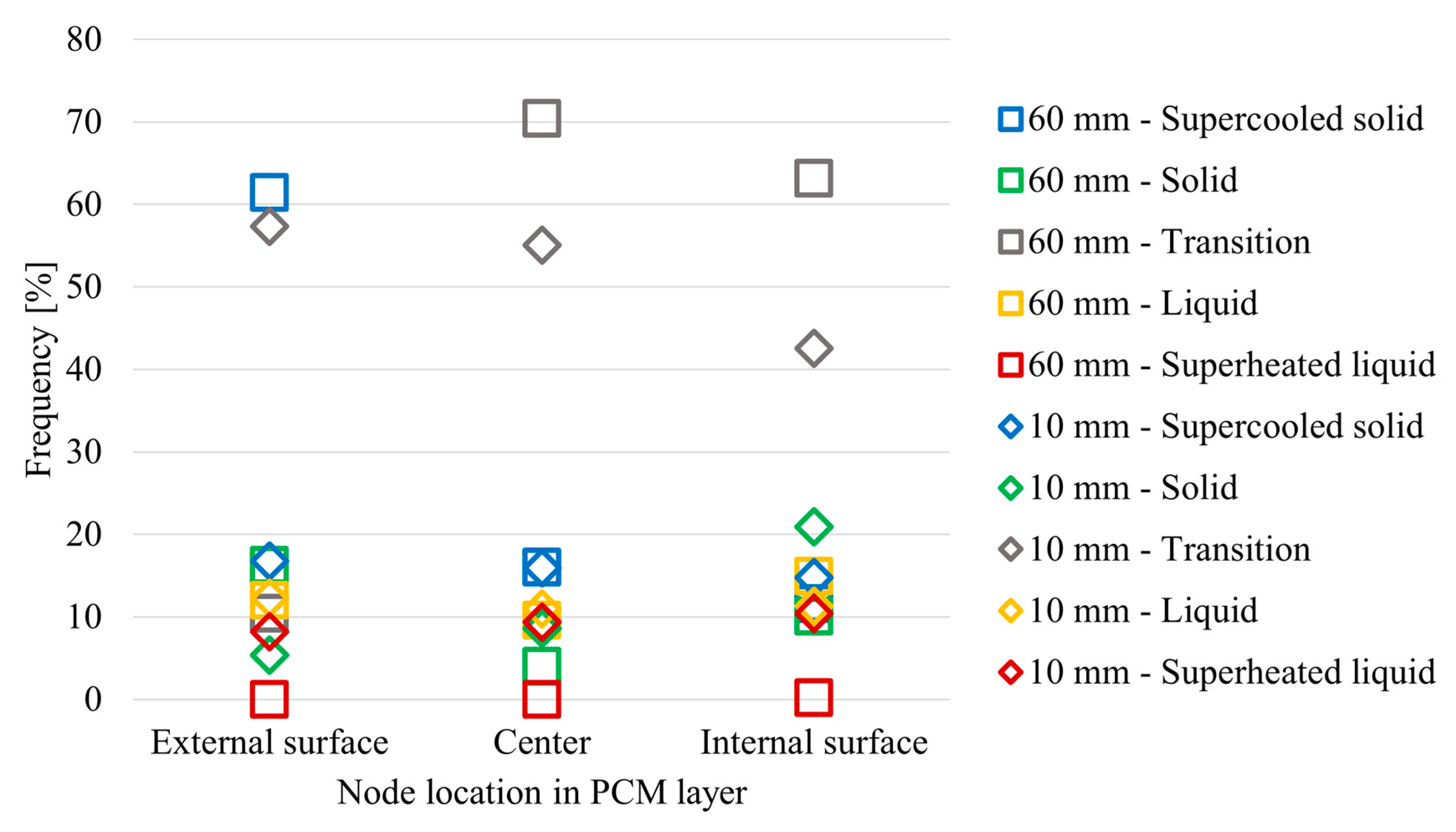3.1. Baseline Validation
To validate the numerical simulation work, the data from the actual house measurements obtained from ReNaM was compared with the simulations in DesignBuilder performed using the Typical Meteorological Year (TMY). To analyze the simulation results, this study began by comparing the representativeness of the temperatures from ReNaM relative to historical data through the cumulative frequency distribution of outdoor temperature and the Earth Mover’s Distance (EMD) metric. The cumulative frequency curves of outdoor temperature (
Figure 6, left) showed a strong correlation, reflected in an EMD of 0.014, close to zero, as illustrated in
Table 8. The low EMD value indicates that the ReNaM data exhibited typical behavior, validating the comparability of the simulation results using a TMY weather data file with data obtained from the measurements.
Since the actual house is heated with radiators, the “Radiators” simulation was used to compare the indoor temperatures. The simulation resulted in a similar distribution of temperatures (
Figure 6, right, yellow vs. black curve) with an EMD of 0.029, as presented in
Table 7. The same analysis was conducted for a smaller time window, focusing on eleven representative winter days (July 18–29), as presented in
Figure 7 and
Figure 8. This analysis was performed to observe divergences that are not appreciable at larger time scales. The EMDs were calculated to be 0.154 for outdoor and 0.049 for indoor temperatures, indicating a more significant divergence in the cumulative frequency curves compared to the annual data, consistent with the reduced time window, although still reasonably low.
Figure 8 shows the comparison of the cumulative frequency distributions of outdoor and indoor temperatures for the shorter timeframe, where, despite the differences shown in the time series in
Figure 7, the overall range and distribution of temperatures between measurements and simulation are relatable. Therefore, the baseline scenario can be considered as validated with the available measurements.
Verifying the computational implementation of the radiant floor followed the study by Baek and Kim [
3] of a house in South Korea. This study obtained a 9.8% difference in the annual energy consumption; however, the thermal transmittance applied in this study was 7.2% higher than that reported by Baek and Kim, as presented in
Table 9. This difference was considered acceptable to continue the analysis.
Replacing radiators with a heated floor enhances comfort conditions inside the house, achieving higher temperatures closer to the target temperature. Including a heat source in the original house floor (“Heated floor v1”) significantly improved indoor temperatures. Subsequently, replacing the house floor with a wet radiant floor (“Heated floor v2”) further enhanced these improvements. The right side of
Figure 6 and
Figure 8 illustrates the increase in indoor house temperature due to changes of HVAC systems, as shown by a shift in the cumulative frequency curves toward higher temperatures (cyan and green curves). This, in turn, results in an increase in EMD values, as presented in
Table 8. The results were analyzed from the perspective of heating gas consumption—and associated carbon emissions—as well as from that of the well-being of the house’s inhabitants, measured as the hours of thermal discomfort for the heated zones. The discomfort hours were calculated directly in DesignBuilder based on ANSI/ASHRAE Standard 55-2017. The results of the heating energy use, emissions, and discomfort hours are presented in
Table 10. The baseline case using radiators presents the lowest gas consumption and, consequently, the lowest carbon emissions. However, the heated floor significantly improves the habitability of the dwelling by reducing the hours of thermal discomfort by 94%.
3.2. Analysis of Heated Floors with PCM
Next, a grid independence analysis for a PCM-enhanced case is shown. This analysis was performed to determine if the level of discretization used in the baseline case was suitable for the cases enhanced with PCMs, given the higher heat storage capacity of the floor construction. This allows the use of a level of discretization adequate for the task, but no higher, therefore reducing the overall computational cost of the complete study. Zone temperature was selected, since it was the variable used for the calibration with measurements from ReNaM in earlier sections.
The parameter modified in EnergyPlus is the
Space Discretization Constant, within the
HeatBalanceSettings:ConductionFiniteDifference object, whose values ranged from 3 (baseline case) down to 0.25. The values of the discretization parameter and the associated number of nodes for the complete heated floor construction are shown in
Table 11.
The zone temperature results for the conditioned living area on the first floor of the house are illustrated in
Figure 9. The simulation for the three levels of discretization ran between August 10 and August 17.
Figure 9 shows that all cases present a similar behavior, and no significant differences in the maximum and minimum temperature values between different levels of discretization exist; therefore, the use of a Space Discretization Constant value of 3 remains suitable for the cases that include PCM in the floor construction. The maximum absolute differences from the baseline for the cases with 150 and 308 nodes are 0.85% and 0.84%, respectively, while the average absolute differences are 0.18% and 0.21%, respectively.
Considering the melting–solidification cycle analysis, only materials RT38, RT42, and RT44 present full operation cycles for some thicknesses. The main differentiating property of these materials is their nominal phase change temperature corresponding to 38 °C, 42 °C, and 44 °C for RT38, RT42, and RT44, respectively. For the following discussion, the term “full operation cycle” has been defined as a certain PCM undergoing a phase change between solid and liquid phases, not necessarily reaching the superheated or supercooled condition. Therefore, other materials and thickness cases have been excluded from further analysis. The selected cases are shown in
Figure 10. It is worth mentioning that none of the PCMs in the DesignBuilder database showed full melting–solidification cycles for heated floor applications, making it necessary to incorporate other PCMs (RT), whose thermophysical properties are presented in
Appendix A.
The best-performing material in terms of energy savings is RT42, with a thickness value of 50 mm, reaching up to 2.8% energy savings. However, an inverse relationship between energy savings and reduction in discomfort hours can be observed, with these thicker cases presenting the lowest reduction in thermally comfortable hours for RT42, although still relatively high, between 13.7% and 21%. RT38 shows a behavior less dependent on thickness, with energy savings between 0.5% and 0.7% and a reduction in discomfort between 14.7% and 18.9%. For thickness values below 25 mm, a trend of increasing thermally comfortable hours can be observed as the thickness value increases. RT44 shows the most particular behavior of the selected materials, with drastically different results between 5 mm thickness and values above 10 mm. For a 5 mm thickness, it shows energy savings of around 1.8% and a reduction in discomfort hours close to 27%. However, for 10 mm thickness onwards, RT44 generates increased energy use, ranging between 4.3% and 1.2% above the reference case, with a light trend toward decreasing energy use as thickness increases. Discomfort hours show diminishing improvements over the reference case as the thickness increases over 10 mm, reaching the lowest value of 0.69% reduction for a thickness of 50 mm.
Figure 10.
Absolute values of energy by heating and discomfort hours for selected PCM and thickness values (
left) and the variation with respect to the base case, Heated floor v2 (
right). A refined parametric analysis was performed for the cases with thickness values below 10 mm, considering thickness increments of 1 mm. The results of this analysis can be seen in
Figure 11. RT44 shows a local maximum value of energy savings for the 5 mm thickness, coincident with a local maximum for discomfort hours reduction of 27%. RT38, with a thickness of 1 mm, shows a maximum energy savings of 2% and a discomfort hour reduction of 12.2%. The different tendencies of the energy savings and discomfort hours reduction curves indicate that incorporating PCM into a building envelope is not a simple concern, since it requires careful consideration of the PCM melting and solidification temperatures and the expected operation temperature of the heating system. Additionally, increasing the amount of PCM, aiming to increase the amount of energy that can be stored in it, can reach a situation in which the excess PCM inhibits the fusion and solidification cycles of the material and increases the energy use of the house. The data of
Figure 10 and
Figure 11 is presented in
Table A2 of
Appendix A.
Figure 10.
Absolute values of energy by heating and discomfort hours for selected PCM and thickness values (
left) and the variation with respect to the base case, Heated floor v2 (
right). A refined parametric analysis was performed for the cases with thickness values below 10 mm, considering thickness increments of 1 mm. The results of this analysis can be seen in
Figure 11. RT44 shows a local maximum value of energy savings for the 5 mm thickness, coincident with a local maximum for discomfort hours reduction of 27%. RT38, with a thickness of 1 mm, shows a maximum energy savings of 2% and a discomfort hour reduction of 12.2%. The different tendencies of the energy savings and discomfort hours reduction curves indicate that incorporating PCM into a building envelope is not a simple concern, since it requires careful consideration of the PCM melting and solidification temperatures and the expected operation temperature of the heating system. Additionally, increasing the amount of PCM, aiming to increase the amount of energy that can be stored in it, can reach a situation in which the excess PCM inhibits the fusion and solidification cycles of the material and increases the energy use of the house. The data of
Figure 10 and
Figure 11 is presented in
Table A2 of
Appendix A.
![Buildings 15 04271 g010 Buildings 15 04271 g010]()
Figure 11.
Energy savings and reduction in discomfort hours for thickness values between 1 mm and 10 mm.
Figure 11.
Energy savings and reduction in discomfort hours for thickness values between 1 mm and 10 mm.
To understand the particular behavior of RT44 between the 1 mm and 10 mm thickness values, a deep dive into the heat flux conditions for the PCM layer nodes is required.
Figure 12 (left) shows the heat flux values between August 10th and August 12th of node 70 for the cases of 3 mm, 5 mm, and 10 mm thickness. Node 70 represents the center of the PCM layer in all three cases. For the 10 mm case, the values of the heat flux during the heat release periods reach about 50% of the values reached by the 3 mm and 5 mm cases. In these figures, a positive value of heat flux represents heat moving into the node, and negative values represent heat leaving the node. The reduction in heat flux found in the thicker PCM cases can be attributed to the additional thermal resistance of the floor construction, due to the increased thickness of the PCM layer. This reduction in heat transfer to and from the PCM layer limits the amount of heat that actually reaches and is stored in the PCM, thus limiting the heat flux from the PCM nodes during charge and discharge. In contrast, Node 74 in
Figure 12 (right) shows a more interior node, further away from the PCM layer. The heat flux values are similar for all cases, which indicates that the effect described can be attributed mostly to the increased thickness of the PCM layer. On the other hand, the differences between the 5 mm case and lower thickness value cases, regarding energy savings, can be attributed to the amount of PCM included. Despite reaching similar values of heat flux, the amount of PCM limits the amount of heat absorbed or released by the PCM layer in the thinner cases. Therefore, the 5 mm case represents a local optimum, given the effects of heat transfer dampening and PCM mass due to the PCM layer thickness described.
To analyze the influence of PCM layer thickness on the PCM performance, we obtained minute-by-minute results for the winter week of analysis. Specifically, we focused on two variables, PCM state and heat flux. PCM state indicates the condition of the PCM node at a given instant. As obtained from EnergyPlus v9.5.0, this variable is represented by values that can range between 2 and −2, which represent supercooled solid (solid cooled below the solidification temperature) (2), solid (1), transition (0), liquid (−1), and superheated liquid (liquid heated above the fusion temperature) (−2). This parameter is highly relevant since the ideal operation of a PCM involves undergoing stages of melting, during which the PCM absorbs heat that is released later during the solidification stage. If a PCM does not undergo these cycles, it is not operating as such. This can happen because the PCM may have a melting temperature far from the temperature ranges of the construction elements during the day. This means that the PCM may remain molten or solid throughout the daily temperature cycle of the building. The phase change of the materials cannot be directly observed from the overall energy simulation results of heating energy use and discomfort hours. However, if the amount of heat absorbed or released is not enough to generate a change of state of the PCM at a given temperature condition, only observing the state parameter will reveal no information about the operation of the material. Even considering a partial process not enough to generate a change of state, a PCM can absorb or release a significant amount of heat in the transition between states. Therefore, the complementary variable of heat flux has been considered. This variable represents the amount of heat going through the node, including any internal heat release or absorption.
As an illustration, a comparison of the values of state and heat flux for the PCM layer nodes of the RT 44 case considering PCM layer thickness values of 10 mm and 60 mm is presented.
Figure 13 shows the results for the state and heat flux for the external surface node of the PCM layer for both cases over a period between August 10th and August 12th. For example, for the 10 mm thickness case, between 12:01 AM and 06:01 AM on August 12th, the PCM remained in the transition state (0); however, the heat flux indicates active thermal behavior, with oscillations that reveal the material was functioning effectively. The 60 mm case node presents lower absolute values of heat flux and less change in state, remaining between the supercooled solid and solid states. On the other hand, the 10 mm case node shows higher absolute values of heat flux and state cycles ranging between supercooled solid and liquid. The differences in heat flux show that the thicker PCM layer limits the amount of heat that reaches the external node and, therefore, limits heat absorption and release, in comparison to the external node in the 10 mm case, which shows swings of larger magnitude between the charging and discharging stages. This observation coincides with that which can be observed in the state curves, with the additional heat flux that reaches the external node in the 10 mm case leading to more frequent and complete cycles of phase change.
Considering the analysis period between August 10th and August 17th,
Figure 14 shows the frequency of time that each of the nodes remains in each state. The biggest difference can be seen for the external surface node, which, in the case of 10 mm, remains in transition between solid and melted states approximately 60% of the time, whereas in the 60 mm case, it remains in the supercooled liquid state 59% of the time. Also,
Table 12 shows the number of state changes over the same period. It can be seen that the 60 mm case presents lower values of state changes than the 10 mm case for all nodes, which indicates that not only does the external node of the 60 mm case spend more time as a supercooled solid, but also that the overall frequency of state change is lower, which negates the benefits of using a PCM. These results indicate that the 60 mm case presents underutilized PCM mass, which, considering its costs, may lead to the existence of a point of diminishing returns regarding the amount of PCM included, and the amount of heat stored and released during the fusion–solidification cycles of the material.
The inverse relationship between energy savings and reduction in discomfort hours can be seen in
Figure 10 for RT 42 and RT 44, although in the case of RT 44, cases between 10 mm and 50 mm thickness do not reach positive energy savings. As discussed in the analysis of RT 44 with thickness values between 1 mm and 10 mm, the thickness of the PCM layer appears to impact the heat transfer conditions in the material. Specifically, at higher thickness values, the heat released by the PCM decreases. This reduction is not seen in nodes of layers closer to the indoors. This indicates that the thickness of the PCM layer thermally insulates the PCM from the indoors.
Figure 13 and
Figure 14 reinforce this takeaway, showing that for higher PCM thickness, the PCM shows lower values of heat flux, dampened by the relatively low thermal conductivity of the thicker PCM layer, and thus experiences fewer, if any, cycles of melting and solidification. However, despite not operating as intended, the thicker PCM layer increases the overall thermal inertia of the construction, effectively increasing the amount of energy it can store. Therefore, the thinner cases can present the opportunity for the stabilization of temperatures during the more frequent phase change stages, at the cost of lower total energy stored. This explains the divergence in behavior between the curves of energy savings and reduction in discomfort hours as functions of PCM thickness. Given the relatively high level of thermal insulation and the location of the PCM closer to the indoors, the effects of outdoor temperatures can be considered unlikely to be the drivers of this behavior, along with the operation conditions of the HVAC system, this being the same for all cases.
